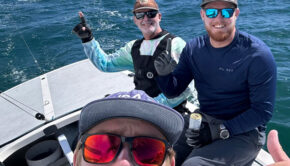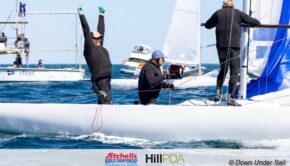Learn from past, Strive for better
Published on February 1st, 2021
Following our report, Future of Etchells Class in the balance, which detailed alleged measurement discrepancies regarding the Australian built Etchells that may have contributed to a dominant performance at the 2019 Class World Championship, Australian Etchells Association president Mark Roberts delivers this update on the history and status of the now famous Mould 11, which is owned by the Australian Etchells Association, and is presently licensed to Pacesetter Yachts for it to build Etchells in Australia:
When Phil Smidmore took over the building of Etchells, in 1995, he began producing boats from the same mould that had been built by Bashford in 1992. The Bashford mould was the 9th Etchells mould. Like Mould 8 (used by Ontario Yachts) and Mould 10 (used by Petticrows and Heritage), Mould 9 had been built from a common plug.
However, it is widely understood and documented that the three moulds produced boats that were not entirely the same. This was most likely the result of the age and condition of the plug, and it being faired prior to each time it was used. When it arrived from the United States in Australia in 1992 to build Mould 9, it was faired by Bashford, and then yet again when it was subsequently used by Petticrows in the UK to build Mould 10.
It is for this reason that since 2007, the One Design Technical Committee (ODTC) had been highlighting the need for the International Class to determine and adopt a hull shape on which all future International Etchells Class hull moulds are to be based.
In 2010, the Australian Association was granted permission to build a new mould. However, due to the condition of the plug, it could not be used to build the new mould. So, with the support of Etchells Class Chief Measurer, Mr Denis Heywood, the Australian Association sought approval to produce a new hull mould from the same mould as used by Heritage. The request went on to observe:
“If it is agreed to adopt the Heritage Mould 10 as the standard International Etchells shape for future moulds, we are heading towards having three identical moulds and a more uniform one design hull, which at present the scanning indicates we do not have. The class would have the current Heritage mould which appears to have a lot of life left in it, a new Australian mould replicating the Heritage mould, and when it comes time for Ontario to replace its mould at some future time it would also be required to replicate the Heritage mould, as would any other new licensed builder.”
The Australian Association’s position was however rejected. Instead, the International Class decided to permit the construction of a mould from a plug that was derived from a digital file containing point cloud data. This data originated from a scan of three hulls produced by each of the builders – an Ontario hull built in 2006, a Heritage hull from 2002, and a Bashford hull built in 1992.
The scans had been acquired during a hull comparison project undertaken by the ODTC between 2005 and 2008. The Australian Association was approved to build a hull mould from the supplied data file. Now albeit that the data was very important, as it was to be the basis of the shape of the new mould, the data was not in a form nor sufficient to fully describe a surfaced model that could be used to machine a plug using CNC technology.
Examples of deficiencies subsequently reported to the International Class included incomplete data at the sheer line, the skeg, the area of the garboard, as well as the stem and gunwale radii. To overcome this, further scanning from existing hulls was carried out on behalf of the Australian Association in respect of the deficient areas, and a full and definitive surface model was derived for the purpose of CNC programming.
A CNC machined plug was produced in late 2010, which was then measured by Mr Heywood prior to use in construction of a mould. Thereafter, a mould was built from the physical plug in early 2011. Pacesetter Yachts, using Innovation Composites as a subcontractor, then produced a prototype hull, which was successfully measured by Denis on 29 July 2011.
Subsequently, concerns were expressed within the One Design Technical Committee regarding a scan taken from the second boat produced from the mould. This issue was however resolved in 2012 within the International Class, after a report produced by Mr Heywood on 12 May 2012, which concluded that:
“The Etchells made from Mould 11 are in every way an Etchells in accordance with the Etchells Class Rules, Tolerances and Specifications.”
Nine years on, and 25 boats have now been built from Mould 11, with 20 of those in the last four years. Apart from a well-publicised modification involving the keel sump in 2016, no other issue has been raised concerning the mould since 2012. That is despite it having been extensively examined and measured by two Class Measurers, who have, in fact, given their tick of approval.
Many have therefore expressed great disappointment that the present concern in relation to Mould 11 only arose following the tremendous 2019 World Championship win by Iain Murray, Colin Beashel, and Richie Allanson, notwithstanding them using the same boat in the 2018 Worlds, where they finished well outside the top 20 in a 94-boat regatta won by a Heritage.
Of course, as we now know, what had changed between those two events were the significant advancements made by them over an 18-month period to the setup of the rig, including a new mast, the sails, and most critically how the boat was sailed. Advancements that they were only too willing to share with the Etchells community and which are now happily replicated by many of the top crews internationally. What had not changed between those two events was the hull and the hull appendages!
Soon after the conclusion of that regatta, the then International Class President, Jim Cunningham, provided an informative analysis of the performance of Mould 11 boats since their inception. This analysis was widely circulated. It clearly revealed that much of the hype being generated after the 2019 Worlds was scuttlebutt. His analysis was subsequently accepted by the then One Design Technical Committee Chairman, and esteemed Naval Architect, Mr Bruce Nelson.
Cunningham’s analysis from August 21, 2019 also stated, amongst many other things, “In the 2018 Brisbane Worlds there were eight of the new Aussie moulded boats, which was the largest concentration of the new Aussie hulls ever at a Worlds, and they finished in 5th, 13th, 15th, 22nd, 37th, 41st, 46th and 63rd out of 94 boats.”
“These newer hulls are arguably owned by keen sailors who recently paid good money for a new boat and presumably have keen programs — yet the ‘special boats’ only had 1 top 10 finish in their own home Aussie waters. It is no wonder, NO ONE, was claiming these were ‘special boats’ as recently as 10 months ago. If the hull is so magical, why did we see this results distribution, given the biggest sample of the Aussie hulls piloted by keen recent buyers?”
Cunningham added, “At the 2018 Brisbane Worlds – 1st, 2nd and 4th were Heritage hulls, yet no one was claiming the end of the one design class then. In fact, the top performing Aussie hull in Brisbane (5th) decided to go ahead and purchase a new Heritage that was used in Corpus to get 4th place.”
Cunningham also pointed out that Team Magpie had been either second or third in three Worlds, with hulls from Pacesetter, Bashford, and Heritage, highlighting the crew, not the boat, as the key.
Drawing from the fact that at the time of his analysis, the Australian builder had produced just half the number of vessels of each of the others over the decade. Notable, Cunningham also pointed out that in 2017 and 18 leading up to Brisbane, they accounted for just a paltry 9.5% of global production.
Yet perhaps most telling of all is that for the five Worlds prior to 2019, the Australian boats had been in the top three (podium) just three times, whereas Ontario and Heritage had been there 10 times each. It says even more when you look at the top 20 place getters, where the new Australian boat featured a mere eight times, whereas the other two combined amassed a staggering 10-fold increase to 80 vessels.
So, it is more than fair to say that they had unde-rperformed against Ontario and Heritage hulls. This is hardly evidence of having any performance advantage, or some kind of ‘development’ style of vessel as has recently been suggested.
Despite all of this, and since June of 2020, the unsubstantiated rumors have regretfully continued. I dealt with much of that in my October 2020 email to the members. However, towards the end of 2020, a new issue arose concerning whether Mould 11 had ever been ‘approved’ by ISAF at the time of its manufacture – a process stipulated in a 1995 licence agreement between ISAF and Pacesetter Yachts.
We asked Australian Sailing to make inquiries from World Sailing on our behalf. Around a week ago, World Sailing informed Australian Sailing and the Australian Association that it had not found any records of World Sailing granting approval to Mould 11. Despite this, for various reasons, it remains unclear to what extent the predecessor to World Sailing was aware of the progress of Mould 11, and the first few boats built from it.
The Australian Association is now working with Australian Sailing and World Sailing to address this new issue. We will keep you apprised on that front.
Many of you may justifiably wonder how it is that we find ourselves in this situation and why it has been allowed to fester for nearly a decade. With sincerity, we are unsure.
One explanation, and we think it the most likely, is that the International Class and builder relied on the custom and practice of the functions of ISAF regarding approvals etc. being delegated to the Class Measurer. It is of note that this practice has continued to this day, where strict compliance to Class Rules has been relaxed with determinations being made by the Class and the Class Measurer without ratification through ISAF. The ongoing controversy surrounding deck recesses is but one clear example, but there are others.
One thing is reasonably clear. As a Class, we need to learn from the past and strive to do better. It is for that reason that last year we sought the assistance of Australian Sailing to work with us, and World Sailing, to get whatever needs fixing in respect of Mould 11 fixed, once and for all!
It is also why the Australian Association strongly advocates a genuine Class wide audit with a particular emphasis on governance, as well as a clean-up of the Rules, along with their policing. We see this is an opportunity. It is time to leave the politics behind to again focus on what the members want this Class to be. For our part, we accept that challenge.
Editor’s note: The reference above to ‘scuttlebutt’ is not a reference to this publication but rather a usage of the broader definition of the word.









 We’ll keep your information safe.
We’ll keep your information safe.